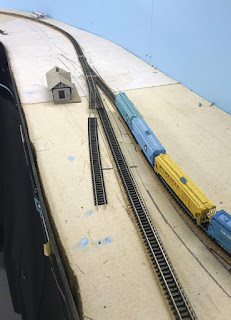*****
What I thought was going to be some major work turned out to be not as bad as I first thought. Last night I finished up the last major realignment on The Little Rock Line: The track between Haskell and Winnfield.
As stated in an earlier post, where the track curved through the backdrop was a little tight and I had a turnout right afterwards which created a bit of an "S" curve. This only reared it's ugly head after I had decided to run some longer equipment. So I turned up the tunes and grabbed the track working tools and dove in.
After some head scratching and conversations with a few friends, the work commenced. I was planning to rip up the biggest share of the track all the way through Haskell, but as it worked out I only needed to pull up the track from the backdrop to the first turnout leading into Malvern.
Here are the before and after pictures.
Haskell, AR
Winnfield, LA
This is the town of Winnfield, not much was changed here. The first thing I needed to do was to slightly swing the mainline to the right and a bit closer to the fascia so I could get it to meet up with the new tracks through the backdrop and the diamond.
Then I played around with the spurs. I wanted to leave the spur for Union Scrap and after some research I decided to add a small pallet company (which was actually on the line and severed by The Rock, but I do believe it was further north on the line).
The rightmost track is the mainline, but it is not used during the sessions and is treated as the EOT. In real life (I believe) Rock Island used tracks owned by the KCS to gain access the yard in Alexandria, LA via Tioga Jct. which is in the bottom of the picture. (I still need to add a section of track from the diamond to the fascia to finish it off).
During the sessions cars are placed on this track and it is the job of the Winnfield local to exercise the journals of the cars stored there. Which means it needs to pull all the cars from the track, move the last car to the front of the line, then replace all the cars to the EOT as part of it's daily duty.
The other industries: Union Scrap is nothing more than a scrap yard that receives empty gons and the newest industry is the pallet company: Boudreaux's Bayou Pallets. This will be a very small industry and will only receive one or two cars at the very most from time to time. Either a 50' flat of lumber or a empty 40' boxcar to be filled with, you guessed it, pallets.
Now with the major realignment projects behind me, it's time to turn to a few smaller projects.
First, the three turnouts that lead into the Riceland facility. These were laid kind of hastily in order to meet the deadline for an earlier ops session. They work, but can be kind of electrically spotty from session to session.
Back in the Winnfield area, it's been decided that the ICG does not need a siding on their track. When the sessions are over, the train never gets run around the itself and winds up getting stripped of it's cars while restaging the cars. So the two turnouts will be removed and reclaimed for another future project I have planned between Fordyce and Haskell. The ICG track will be shortened a bit, this will allow me to move it a bit closer the backdrop and hopefully be able to partially conceal it with a tree line or low rising hill.
Lastly, again while doing the research, I stumbled upon another quaint little on-line industry. In Ruston, LA The Rock would drop off one or two open hoppers of agricultural limestone on the house track. This in turn would be unloaded via an auger into farm trucks and spread onto local fields.
So returning to Ruston one more time, I plan to install a simple siding like this.
This type of simple industry was part of what drew me to model this section of The Rock. It reminds me of the article in an older issue of Model Railroader where they designed a simple 10' x 10' layout that portrayed Southern Railway's Murphy's branch line. If stock High Hood locomotives had been available back then, I may have actually been modeling the Southern instead of The Rock?
In closing this post, I am so glad that I only tacked down the track throughout the layout. This has allowed me to run Op Sessions over the last several years and see what and where any changes needed to be made. A few more sessions will be needed to make sure these changes are in fact the final changes before proceeding with any scenery.










Great pics of the evolution!
ReplyDeleteThanks Karl.
DeleteMy intent is to help the followers understand what I'm up against and what I had to go through to get it done. Basically to see the BIG picture.
I've read posts of what others had done and had no idea why or what they had to do. Glad you like them!